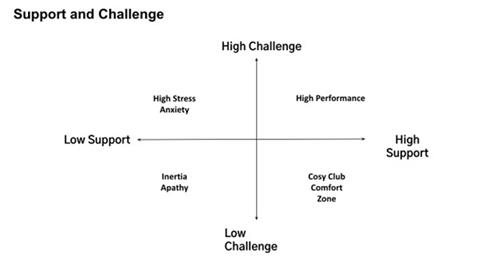In the second piece in a series, executive search and coaching company Quicksmith (and some friends) explain the best approach to running a business under pressure

Dear Quicksmith
I’ve been at the helm of a series of production companies over the years. I’ve been through many difficult periods but this feels different. I’m seriously worried about whether the company will survive. I’m desperately cutting costs and trying to find alternative revenue streams whilst trying to keep everyone around me hopeful and motivated for a future I’m not sure is even going to come. I’m increasingly short tempered and I’m not sleeping well. I can’t seem to stop spinning and I feel like I’m going under. What can I do?
- Anonymous
Dear Anonymous
Let’s first acknowledge that you are in a very difficult position. The biggest drivers of stress are loss, change, responsibility without control, uncertainty about the future and scarcity of resource. You are contending with all of them.
We are experiencing a fundamental shift and sadly some companies will go under. More positively, the ad market has shown a degree of recovery in the 1st and 2nd quarters and if that solidifies in 3rd we would see more commissioning by the 4th.
So what should your approach be? Here are some suggestions
The organisational expert: How can leaders make an immediate difference?
- Bree Brown, Organisational psychologist

“Lack of control can cause stress, which can restrict the creative or problem-solving part of our brain. Throw uncertainty into the mix, and decision-making becomes harder, too.
Building guaranteed “small wins” into the working day for you and your teams can generate a sense of certainty. Ask yourself the question: if 99% of the problems are outside my control, what is the 1% I can control?
When it comes to cuts and redundancies, “cut once and cut deep”, as hard as it is, can help reduce lingering anxieties. By being decisive, fair, empathic, and transparent, you can negate some of the adverse effects of redundancies for those who remain, such as lack of trust, less hope for the future and lower job satisfaction.
The pragmatist: How best to manage your overhead and staff?
- Dani Neumann, managing director Spun Gold TV

It’s time to be agile and say “yes” to work you might have said “no” to before, even if it doesn’t make a meaningful profit. If it keeps the lights on and keeps people working just say yes.
For companies that have had to downsize, it’s all hands to the pump. No room for big egos and hierarchies. Just get on with it even if it’s doing things that are not traditionally your job.
In terms of freelancers, with so many talented people out of work, we have sometimes offered two people a job share. Not ideal for either person, but better that they both have some kind of employment until things pick up.
The realist: Big picture, what’s going on in the market?
- Derren Lawford, Founder & CEO Dare Pictures

We’re halfway through an era of international disruption with constant step changes. Progress accelerates and then plateaus, before the next acceleration and commissioners’ whole strategies can change the next day.
You need to be disciplined in how to approach change. It is important to treat a day like a week, a week like a month and a month like a year.
There is no way we can get through this without collaborating more smartly. In the social media world, success is predicated on amplification and collaboration. If influencers don’t collaborate, they wither away. Take the same approach.
The survivor: What if the worst happens and a company can’t be saved?
- Paul Heaney, CEO BossaNova Media

The main thing that helped me was telling everyone how tough it was. True to form, I overshared, but a problem shared is a problem aired. We have to learn how to help ourselves, as the only expert on you is you.
My favourite Irish phrases, ‘what doesn’t kill you makes you stronger’ and ‘necessity being the mother of invention’ are only one half of the story. If adrenaline sticks around too long it can become destructive; you can’t sleep, think or breathe as your body is stuck in constant fight-or-flight.
It means you’re less equipped to deal with problems when you need to be empowered and enabled. Calming down is as important as speeding up. I was energised mostly by those that joined me in my new venture. Their enthusiasm, drive, ambition, skills and competency were key, it’s humbling and gets you out of bed.
Four years later I’m in the best company I’ve ever had, with the best people, doing my best work. Things break, things die but with the right people, you can always repair and regrow.
The coach: How can leaders help to manage fear in organisations?
- Dee Smith, Cofounder Quicksmith & Executive Coach

A wise woman once told me a story. “If a bear enters a room and the leader says “Don’t be afraid, there is no bear” it doesn’t make people feel safe. Quite the opposite. Now they doubt the leader’s ability to see danger and they’ve lost their agency to react.
Trying to pretend things are ok doesn’t protect people and taking it all on yourself just takes you under. What’s left? Try open, honest communication with your team about the pain/danger points of your situation
The right support is also key. Do a quick audit of what support exists for you, your team and the company and build on it. It doesn’t have to be expensive, (get creative, find out what lifts and connects your people). If you have stripped support out, this simple graphic illustrates why this could be a fundamental error.
High Challenge + High Support = High Performance
High Challenge + Low Support = High Stress and Anxiety
If you can name fears, share them, build in the right support and create agency in every individual, you are taking solid steps back to safety for you, your team and your company.






























No comments yet